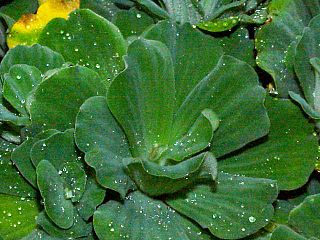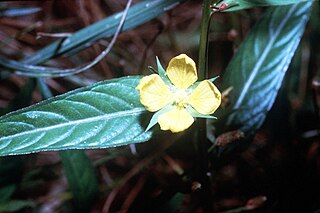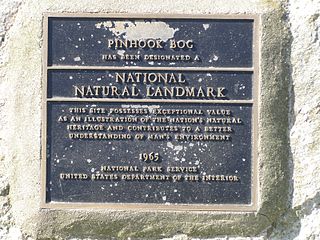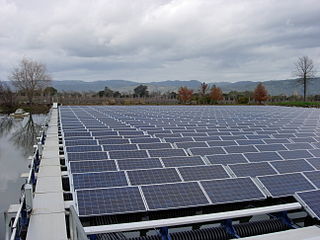
Aquatic plants are plants that have adapted to living in aquatic environments. They are also referred to as hydrophytes or macrophytes to distinguish them from algae and other microphytes. A macrophyte is a plant that grows in or near water and is either emergent, submergent, or floating. In lakes and rivers macrophytes provide cover for fish, substrate for aquatic invertebrates, produce oxygen, and act as food for some fish and wildlife.

The Sudd is a vast swamp in South Sudan, formed by the White Nile's Baḥr al-Jabal section. The Arabic word sudd is derived from sadd, meaning "barrier" or "obstruction". The term "the sudd" has come to refer to any large solid floating vegetation island or mat. The area which the swamp covers is one of the world's largest wetlands and the largest freshwater wetland in the Nile Basin.

Aquaponics is a food production system that couples aquaculture with hydroponics whereby the nutrient-rich aquaculture water is fed to hydroponically grown plants.

Salvinia, a genus in the family Salviniaceae, is a floating fern named in honor of Anton Maria Salvini, a 17th-century Italian scientist. Watermoss is a common name for Salvinia. The genus was published in 1754 by Jean-François Séguier, in his description of the plants found round Verona, Plantae Veronenses Twelve species are recognized, at least three of which are believed to be hybrids, in part because their sporangia are found to be empty.

A floating island is a mass of floating aquatic plants, mud, and peat ranging in thickness from several centimeters to a few meters. Floating islands are a common natural phenomenon that are found in many parts of the world. They exist less commonly as an artificial phenomenon. Floating islands are generally found on marshlands, lakes, and similar wetland locations, and can be many hectares in size.

Pistia is a genus of aquatic plants in the arum family, Araceae. It is the sole genus in the tribe Pistieae which reflects its systematic isolation within the family. The single species it comprises, Pistia stratiotes, is often called water cabbage, water lettuce, Nile cabbage, or shellflower. Its native distribution is uncertain but is probably pantropical; it was first discovered from the Nile near Lake Victoria in Africa. It is now present, either naturally or through human introduction, in nearly all tropical and subtropical fresh waterways and is considered an invasive species as well as a mosquito breeding habitat. The genus name is derived from the Greek word πιστός (pistos), meaning "water," and refers to the aquatic nature of the plants. The specific epithet is also derived from a Greek word, στρατιώτης, meaning "soldier," which references the sword-shaped leaves of some plants in the Stratiotes genus.

Ludwigia alternifolia, commonly known as seedbox, bushy seedbox, rattlebox, and square-pod water-primrose, is a herbaceous perennial plant of the family Onagraceae. It is native to central and eastern North America, growing in marshes, wet meadows, and swamps. It has yellow, four-petaled flowers and brown seed pods that are shaped like a cube.

Ludwigia sedoides, commonly known as mosaic flower and false loosestrife, is a herbaceous perennial plant of the family Onagraceae. It has yellow flowers that bloom from June to August. Native to Brazil and Venezuela, its habitat includes wet, swampy localities.

Ludwigia hexapetala, the water primrose, is a herbaceous perennial plant of the family Onagraceae. Native to Central and South America, its habitat includes the margins of lakes, ponds, ditches, and streams. Its stems may be immersed or fully emergent. It is a noxious invader of aquatic ecosystems in North America.

Hydrocotyle ranunculoides, known commonly as floating pennywort, or floating marshpennywort, is an aquatic plant in the family Apiaceae. It is native to North and South America.

Pinhook Bog is a unique bog in Indiana that has been designated a National Natural Landmark. It is part of Indiana Dunes National Park, an area that many citizens, scientists, and politicians fought hard to preserve. Its sister bog, Volo Bog, is located nearby. The bog contains a large variety of plants, including insect eating plants, tamarack trees, stands of blueberry bushes, and floating mats of sphagnum moss. Pinhook Bog is about 580 acres (2.3 km2), a quarter of which is a floating mat of sphagnum peat moss. A "moat" separates the bog from the uplands.

The comb-crested jacana, also known as the lotusbird or lilytrotter, is the only species of jacana in the genus Irediparra. Like other jacana species, it is adapted to the floating vegetation of tropical freshwater wetlands.

The white-winged coot is a species of bird in subfamily Rallinae of family Rallidae, the rails, gallinules, and coots. It is found in Argentina, Bolivia, Brazil, Chile, Paraguay, Uruguay, and the Falkland Islands.

Ludwigia peploides is a species of flowering plant in the evening primrose family known by the common names floating primrose-willow and creeping water primrose. It is native to Australia, New Zealand, North America, and South America, but it can be found on many continents and spreads easily to become naturalized. It is well known as a troublesome aquatic noxious weed that invades water ecosystems and can clog waterways. This is perennial herb which grows in moist to wet to flooded areas. The stem can creep over 2 meters long, sometimes branching. It spreads to form mats on the mud, or floats ascending in the water. The leaves are several centimeters long and are borne in alternately arranged clusters along the stem. The flower has 5 to 6 lance-shaped sepals beneath a corolla of 5 or 6 bright yellow petals up to 2.4 centimeters long. The fruit is a hard, cylindrical capsule.

An aquatic weed harvester, also known as a water mower, mowing boat and weed cutting boat, is an aquatic machine specifically designed for inland watercourse management to cut and harvest underwater weeds, reeds and other aquatic plant life. The action of removing aquatic plant life in such a manner has been referred to as "aquatic harvesting".

Crassula ovata, commonly known as jade plant, lucky plant, money plant or money tree, is a succulent plant with small pink or white flowers that is native to the KwaZulu-Natal and Eastern Cape provinces of South Africa, and Mozambique; it is common as a houseplant worldwide. Much of its popularity stems from the low levels of care needed; the jade plant requires little water and can survive in most indoor conditions. It is sometimes referred to as the money tree; however, Pachira aquatica also has this nickname.

Ludwigia adscendens, the water primrose, is a species of flowering plant in the evening primrose family. Its native distribution is unclear. It is now a common weed of rice paddies in Asia and occurs also in Australia and Africa, but may have originated in South America.

Ludwigia octovalvis is a species of flowering plant in the Onagraceae family known by the common name Mexican primrose-willow. Its native distribution is unclear, but can be found in Central America, Australia, South-East Asia, Tamilnadu (IND), the Middle East, the Central-West African regions and spreads easily to become naturalized. It is also cultivated as an aquatic plant. The plant is known for its anti-aging properties. The species is sometimes regarded as an invasive species and is classified by IUCN as of Least Concern with stable populations. An adult plant is one meter tall on average but is able to grow taller. It spreads to form mats on the mud, rooting at nodes in contact with the substrate, or floats ascending in the water. Its flowers are yellow in appearance. They are made up of green and red stems. They yield small capsular fruits containing many minute seeds.

Floating solar or floating photovoltaics (FPV), sometimes called floatovoltaics, are solar panels mounted on a structure that floats on a body of water, typically a reservoir or a lake such as drinking water reservoirs, quarry lakes, irrigation canals or remediation and tailing ponds. A small number of such systems exist in China,France, India, Japan, South Korea, the United Kingdom, Singapore, and the United States.

Ludwigia grandiflora, commonly referred to as Water primrose, is an aquatic plant of the order Myrtales.


















